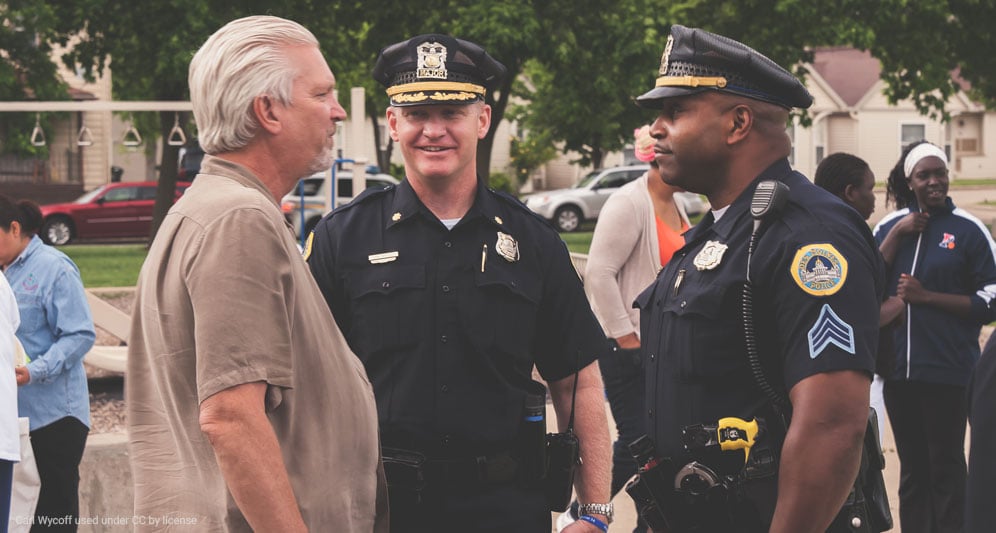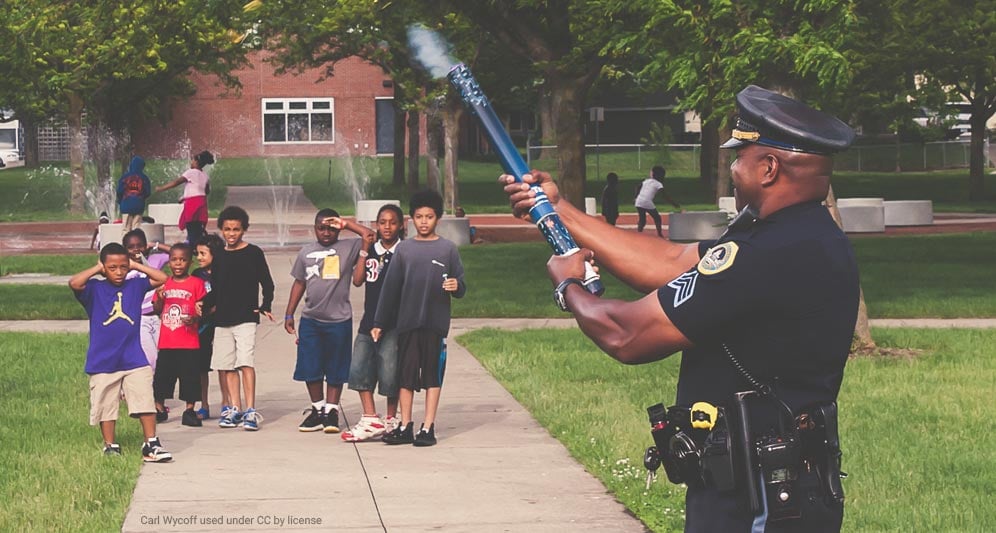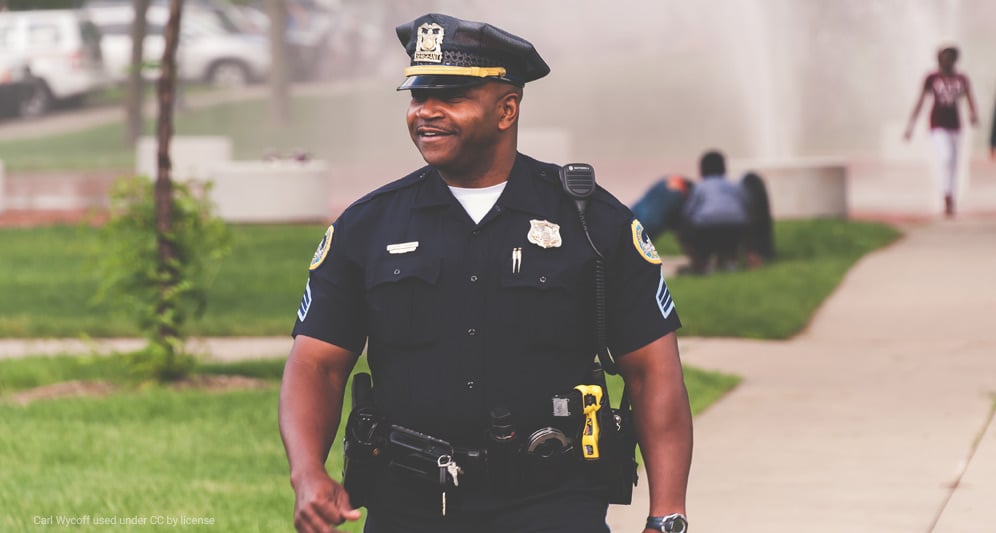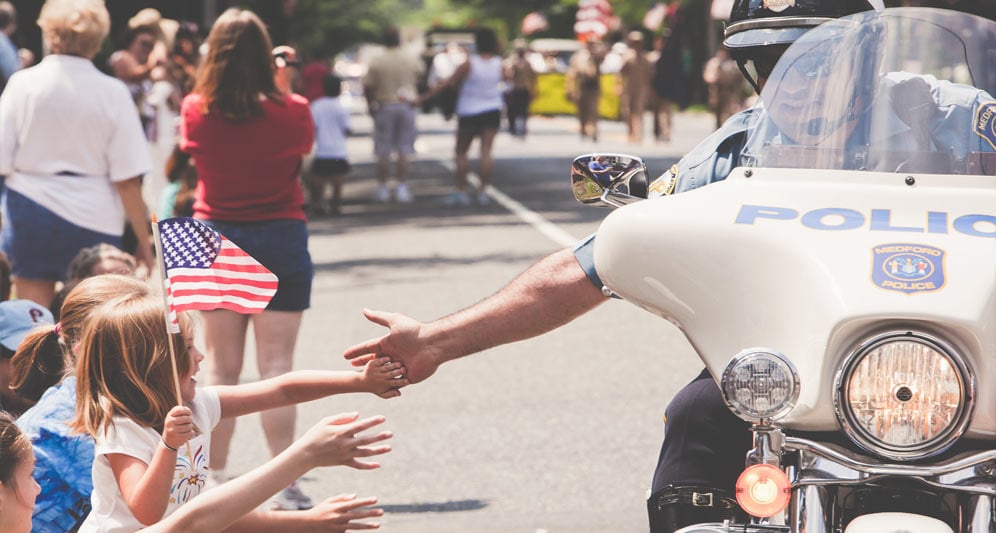Article highlights
- Definition of the terms constitutional policing and community policing.
- Recognizing where the two strategies intersect.
- Ways to support constitutional policing while building community relations.
Trust is a foundational part of police-community relations. But recently, there has been an increasing lack of trust between police and the public.
As law enforcement leaders have discussed how to repair this trust, many have focused on constitutional policing and community policing.
Effective law enforcement agencies combine constitutional and community policing methodologies. The two go hand in hand, but they’re not the same thing.
Constitutional policing provides the foundation for ethical, lawful practices that seek to protect civilians’ civil rights. Community policing builds on that framework and applies it to the needs and concerns of a particular community.
Together, constitutional and community policing practices build trust between police officers and the people they serve. This makes law enforcement easier, as people are more willing to help and cooperate with police.
As the President’s Task Force on 21st Century Policing pointed out, “People are more likely to obey the law when they believe that those who are enforcing it have the legitimate authority to tell them what to do … The public confers legitimacy only on those they believe are acting in procedurally just ways.”
Ultimately, police officers are accountable to the public – to the people they serve. Departments must teach officers to keep that in mind. Officers should value civil rights, respect every member of their community, and see their work as an investment in the community.
To understand how constitutional policing and community policing apply to your department, we first must further examine what each one is.
What Is Constitutional Policing?
Simply put, constitutional policing is policing that follows the U.S. Constitution and upholds people’s civil rights. Constitutional policing ensures that law enforcement officers treat everyone fairly and impartially.
Constitutional policing operates within the boundaries set by the Constitution, court decisions, laws, and regulations. But correct constitutional policing is more than just policies that hold up in court.
A report on constitutional policing by the Police Executive Research Forum points out the difference.
It says police departments should continually examine practices to make sure they “advance the broad constitutional goal of protecting everyone’s civil liberties and providing equal protection under the law.”

A foundation of constitutional policing should inform everything police do. However, there are certain areas where law enforcement leaders should be especially careful to promote constitutional policing.
These include police use-of-force, stop and frisks, issues of racial bias, and interactions with people with mental illness.
In every interaction, police must walk the line of enforcing the law to keep people and communities safe, while also respecting the rights of every individual they interact with.
“The vision of policing in the 21st century should be that of officers as guardians of human and constitutional rights,” says the President’s Task Force.
Once your agency has established a base of constitutional policing, you can then apply and adapt those concepts to your community.
What Is Community Policing?
As law enforcement leaders have discussed police accountability and criminal justice reform, many have advocated a return to community policing.
The President’s Task Force on 21st Century Policing upholds community policing as one of its pillars of effective law enforcement.
The report defines community policing as “work[ing] with community residents to identify problems and collaborate on implementing solutions that produce meaningful results for the community.”

Advocates of community policing recognize that policing methods and practices won’t look the same in every city. Police need to be aware of the makeup of the communities they are policing.
Communities include diverse groups – racial minorities, the LGBTQ community, the mentally disabled, immigrants, and more. Community policing prompts police to know and consider the needs of every group.
Community-oriented policing takes a proactive approach to public safety. Departments may ask community members to voice their concerns and speak to policy.
They may even invite representatives from diverse groups in their city to conduct seminars during officer training.
Perhaps most importantly, a community-policing philosophy emphasizes police relationships within the community.
Rather than just sending officers into an area to respond to calls, many departments are requiring officers to patrol on foot. They encourage officers to get out of their squad cars and regularly interact with civilians.
Community policing tactics have been credited with improving police-community relations in areas such as Dallas and Eastern Michigan. When officers and civilians get to know one another outside of law enforcement interactions, they are more likely to trust each other.
Officers respect citizens and see themselves as community guardians. Civilians are willing to work with police and see them as allies.
The Intersection of Constitutional and Community Policing
Effective law enforcement embraces both constitutional and community policing. The two methodologies can work independently of one another, but they are stronger when combined.
Constitutional policing lays the groundwork for community policing.
Civilians aren’t likely to be willing to interact with the police on a daily basis if they don’t trust the police to respect their civil rights. Community policing won’t do much good without constitutional practices in place.
However, without boots on the ground in community policing, constitutional policing can easily remain just an abstract concept. Community policing allows officers to put constitutional policing into practice.

The PERF report explains that establishing effective constitutional policing practices hinges on developing healthy relationships with the community.
According to the report, the Constitution should ultimately be the foundation for all police work. Finding ways to maintain constitutional policing will help build community trust. From there, officers can engage the community in more meaningful ways, both improving their reputation and getting help when needed.
Encouraging constitutional and community policing practices in your department
The PERF report highlights a few key ways to support constitutional policing while building community relations:
- Openness about how race issues impact policing in the community – including holding community forums and similar events.
- Police support for peaceful, legal protests.
- Fostering transparency and relationships between community members and police – possibly through partnerships, such as having civilian instructors get involved in training.
- Training officers in how they can interact with citizens in the most effective ways possible.
The Police Executive Research Forum isn’t the only group embracing the relationship between community and constitutional policing.
The Atlanta Police Department also released materials detailing the ways that constitutional policing best practices can support community policing goals.

Former Atlanta Police Chief George Turner suggests that law enforcement agencies can build public trust through actions such as:
- Providing transparent and timely information about the investigation process when a civilian files a complaint against an officer.
- Creating training that fosters a culture of empathy, dignity, and respect.
- Recognizing the unique needs and challenges of particular groups within the community – such as youth, non-English speakers, LGBTQ, and minorities.
The overall theme of this advice is straightforward: police must work to maintain the public’s trust or risk having the relationship with citizens erode. Both constitutional and community policing play vital roles in maintaining this trust.
It’s not enough for your department to simply make sure your practices are constitutional or implement a community policing program.
Department leaders must work to create a culture that upholds the rights and dignity of every citizen and encourages officers to know the people they are policing. By embracing both constitutional policing and community policing, your department can build trust and effectively serve your community.



